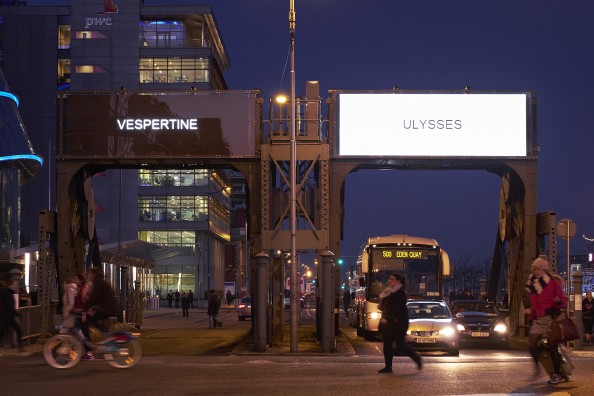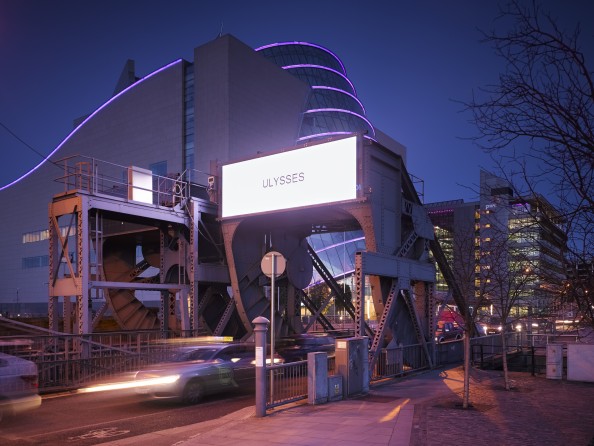Cityscape with Sleeping Dog
Isabel Nolan, 2024
Nolan’s gentle response is a counterpoint to the bustling, and night-time hi-octane energy of Temple Bar.
Temporary Location: Scherzer Bridge, North Wall Quay
Dublin Ships by Cliona Harmey was a temporary public artwork commissioned by Dublin City Council as part of their Strand 2 public art programme: “Interaction with the City” curated by Ruairí Ó Cuív. The Dublin Ships project was sited at a busy intersection at the Scherzer Bridges in the docklands area of Dublin City.
The artwork was generated using the live maritime information system (AIS) which is normally used to track the location of ships/vessels. Two electronic signs displayed in ‘real time’ the names of ships entering and leaving Dublin Port. The artwork used the ship names to encourage reflection on the port's daily traffic via their associations with history, locations, cargo etc. The juxtaposition of the two ship names generated a form of poetic writing. The work also interrupted the speed of instantaneous data and returned it to the speed of the movement of real entities in space. The project was designed to be seen over a sustained period of time and was aimed at both a local audience as well as vehicular and pedestrian commuters.
The media communication strategy was an integral part of the project and project mediation was supported by a custom designed website, and a social media twitter-bot (which remained active and persisted long after the physical project had ended).
The significant scale of the commission, the public interest and the particular context within the port area of Dublin city, was supported by the development of an Engagement Programme aimed at National Schools in the Docklands area. This programme was developed by Liz Coman, education curator (Dublin City Arts Office) in collaboration with artists Cliona Harmey (author of Dublin Ships), Martina Galvin (artist and educator), Katy Fitzpatrick (art educator), and Dr Aislinn O’Donnell (aesthetic philosopher). The engagement program used the Dublin Ships installation as a springboard for discussion with the children being encouraged to act as researchers. The workshop sessions included an experiential visit to the port and in class sessions where the children were encouraged to think about ‘what art is’ in the broadest sense, and also to make their own art which related to both their own ideas about the port public art in general and the Dublin Ships artwork which was situated in the vicinity to where they lived and went to school.


Nasc seachtrach, oscalaíonn sé i gcluaisín nua
Nasc seachtrach, oscalaíonn sé i gcluaisín nua
Nasc seachtrach, oscalaíonn sé i gcluaisín nua
Nasc seachtrach, oscalaíonn sé i gcluaisín nua
Nasc seachtrach, oscalaíonn sé i gcluaisín nua
Nasc seachtrach, oscalaíonn sé i gcluaisín nua
Nasc seachtrach, oscalaíonn sé i gcluaisín nua
Nasc seachtrach, oscalaíonn sé i gcluaisín nua
Isabel Nolan, 2024
Nolan’s gentle response is a counterpoint to the bustling, and night-time hi-octane energy of Temple Bar.